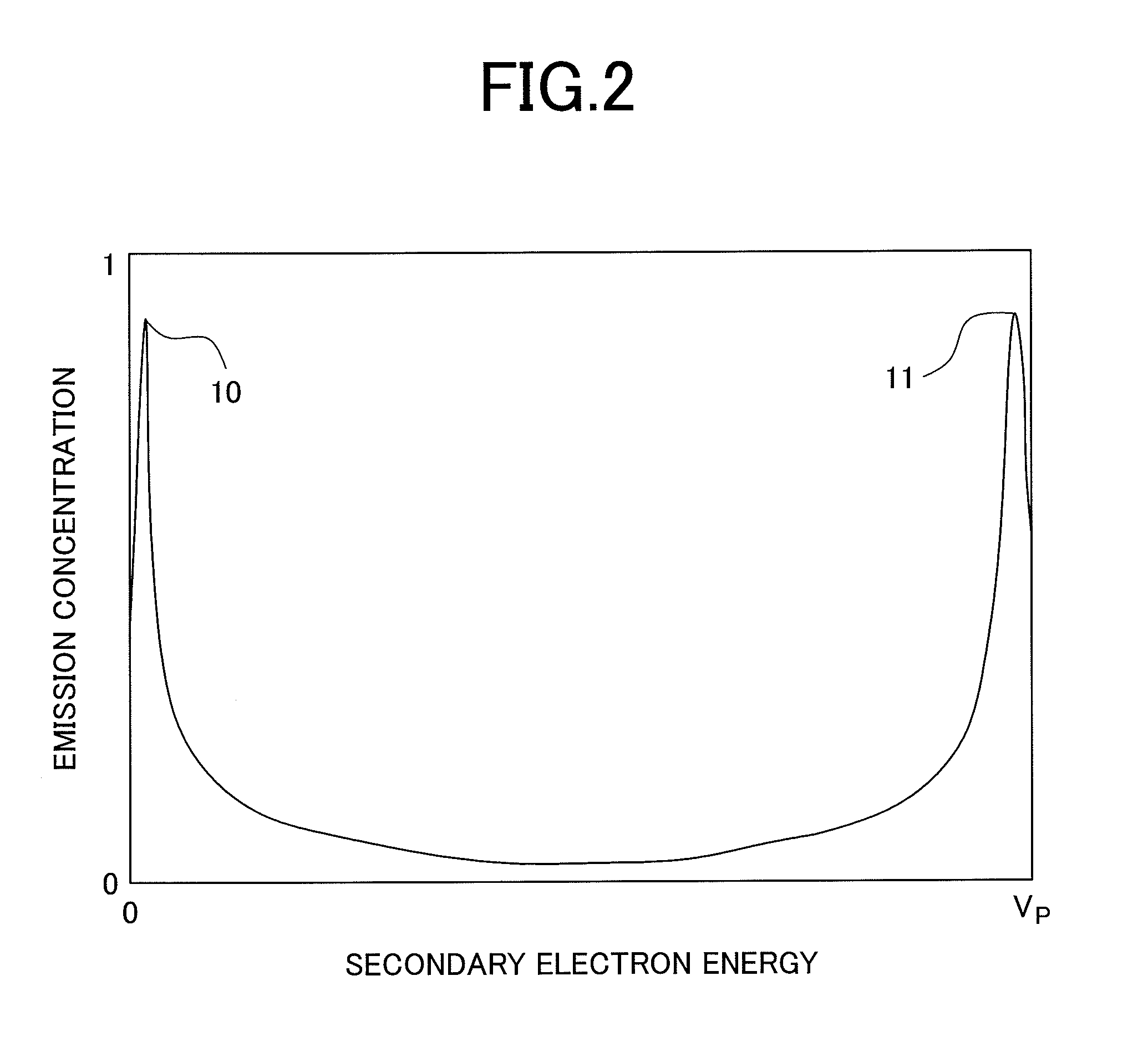Electron Beam Apparatus and Electron Beam Inspection Method
a technology of electron beam and electron beam, which is applied in the direction of material analysis using wave/particle radiation, instruments, nuclear engineering, etc., can solve the problem that the high elevation angle component at the generational position of the secondary particle cannot be sufficiently separated from the low-velocity component, the image with a small roughness (shallow) cannot be acquired and the inspection or measurement of a sample cannot be qualified in a short time. , to achieve the effect o
- Summary
- Abstract
- Description
- Claims
- Application Information
AI Technical Summary
Benefits of technology
Problems solved by technology
Method used
Image
Examples
first embodiment
[0046]As the first embodiment, an adaptation to a scanning electron microscope will be described below.
[0047]FIG. 6 shows the fundamental configuration of a charged-particle beam apparatus in accordance with the first embodiment. The charged-particle beam apparatus in accordance with the present embodiment includes: an electron optical system formed in a vacuum housing 125; an electron optical system control apparatus 124 disposed in a peripheral of the charged-particle beam apparatus; a host computer 121 that controls individual control units included in the control apparatus 124 and supervises the entire charged-particle beam apparatus; an operating console 122 connected to the control apparatus; and a display 123 including a monitor on which an acquired image is displayed. The electron optical system control apparatus 124 includes a power supply unit that feeds a current or a voltage to the elements constituting the electron optical system, and signal control lines over which a c...
second embodiment
[0062]FIG. 9 shows the fundamental configuration of a charged-particle beam apparatus in accordance with the second embodiment. The charged-particle beam apparatus in accordance with the present embodiment has a configuration devoid of a reflecting member, and is intended to realize the same constituent feature as that of the configuration described in relation to the first embodiment despite a simpler configuration. The components of the apparatus will be described in conjunction with FIG. 9. However, as to the components whose operation, function, or arrangement are identical to those of the components included in the first embodiment, the explanation is omitted.
[0063]The charged-particle beam apparatus in accordance with the present embodiment includes an electron optical system formed in a vacuum housing 170, an electron optical system control apparatus 169, a host computer 166 that supervises the entire apparatus, an operating console 167 connected to the control apparatus, a d...
third embodiment
[0067]FIG. 10 shows the fundamental configuration of a charged-particle beam apparatus in accordance with the third embodiment of the present invention. The charged-particle beam apparatus in accordance with the present invention includes, in addition to a reflecting member, an ExB deflector. As a trajectory separating means of a secondary electron from the trajectory of a backscattering electron, magnetic poles are substituted for the assist electrode. Referring to FIG. 10, the components of the apparatus will be described below. However, a description of the components whose actions, capabilities, or dispositions are identical to those of the components included in the first embodiment will be omitted.
[0068]The charged-particle beam apparatus in accordance with the present embodiment includes an electron optical system formed in a vacuum housing 225, an electron optical system control apparatus 224, a host computer 221 that controls the whole of the apparatus on a centralized mann...
PUM
 Login to View More
Login to View More Abstract
Description
Claims
Application Information
 Login to View More
Login to View More - R&D
- Intellectual Property
- Life Sciences
- Materials
- Tech Scout
- Unparalleled Data Quality
- Higher Quality Content
- 60% Fewer Hallucinations
Browse by: Latest US Patents, China's latest patents, Technical Efficacy Thesaurus, Application Domain, Technology Topic, Popular Technical Reports.
© 2025 PatSnap. All rights reserved.Legal|Privacy policy|Modern Slavery Act Transparency Statement|Sitemap|About US| Contact US: help@patsnap.com



